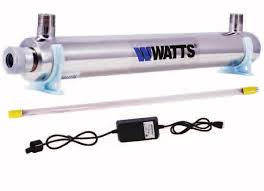Ultraviolet Light Bacterial Removal System
Water Purification System

It’s impossible to tell if bacteria are present in your water without a special test. If any of the following physical symptoms are present in any members of your family, you can look for them and have your water checked with a water purification system.
- Gastrointestinal problems (I.E. diarrhea, bloody diarrhea, vomiting, cramps, nausea)
- Legionnaire’s Disease (a type of pneumonia)
- Hemolytic uremic syndrome (red blood cells are destroyed and kidneys fail)
- Headaches
How harmful is bacteria?
We consider the presence of any bacteria in your water to be harmful. The most dangerous forms of bacteria are fecal coliform better known as E. coli. The presence of fecal coliform bacteria is a sure sign that your water has been contaminated with fecal material from humans or animals. The source water may be contaminated by pathogens, disease-producing bacteria, or viruses, which can also exist in fecal material. Some waterborne pathogenic diseases include typhoid fever, viral and bacterial gastroenteritis, and hepatitis A.
Here’s a quote from the EPA:
“Infection often causes severe bloody diarrhea and abdominal cramps; sometimes the infection causes non-bloody diarrhea. Frequently, no fever is present. It should be noted that these symptoms are common to a variety of diseases, and may be caused by sources other than contaminated drinking water.”
“In some people, particularly children under 5 years of age and the elderly, the infection can also cause a complication called hemolytic uremic syndrome, in which the red blood cells are destroyed and the kidneys fail. About 2%-7% of infections lead to this complication. In the United States, hemolytic uremic syndrome is the principal cause of acute kidney failure in children, and most cases of hemolytic uremic syndrome are caused by E. coli O157:H7. Hemolytic uremic syndrome is a life-threatening condition usually treated in an intensive care unit. Blood transfusions and kidney dialysis are often required. With intensive care, the death rate for hemolytic uremic syndrome is 3%-5%.”
How does an Ultraviolet Light work?
Our Ultraviolet Light system monitors the UV bulb at all times. As long as the UV bulb is functioning at it’s normal level, the water purification system allows water to enter.
The water moves down through the tank where it then enters a stainless steel exposure chamber which contains the UV bulb. Water is forced to pass close to the UV bulb where any bacteria are immediately destroyed. The water then moves up to the top of the stainless steel exposure chamber and passes from the unit, ready for drinking.
Ultraviolet Light Specifications
- Maximum service overflow rate – 12 gpm
- Inlet/Outlet size – 1″
- Overall Height – 49″
- Width – 9″
- Monitoring – Electronic control panel provides power, audible alarm, solenoid valve control and sensor circuits.
- Automatic shut-off – Solenoid valve shuts water flow off in the event of a system failure.
- Acrylic glow plug – Shows at a glance if the system is functioning.
A simple water test, that only takes a few minutes, can determine the level of chlorine in your water. Metro Water filters offers an on-site consultation. Please give us a call and we’ll set up an appointment to test your water on site.































